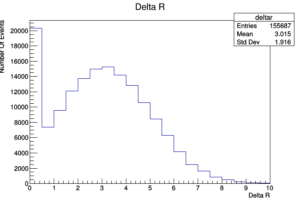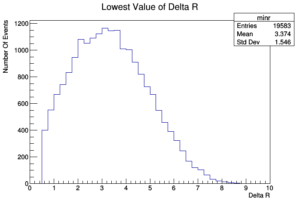I have made it to Boston and have started work at BU! I’ve been working directly with a 1st-year graduate student at BU(Alp). He has been helping me to make these beautiful graphs and pull data from a database of simulated particle accelerator collisions. My project with this talented group is to hopefully create a trigger path that will be used in run 3 of CERN, the particle accelerator in Switzerland. A trigger is basically a filter for the particles created in the collision of the two protons in the particle accelerator. There are two triggers within the CERN system, the L1T(Level one Trigger) which does basic calculations at high speed to filter out all data that is useless to the scientists using this system, and the HLT(High-Level Trigger) which filters the data sent to it by the L1T at a slower rate and more sophisticated system. There are several hundred to a thousand trigger paths for each trigger and my end goal is to create a trigger path that will be sent to the HLT in order to get data for low-mass axion-like particles. My first week at BU has been mostly spent learning how to pull data from files and plotting this data onto histograms. A few are shown here.

 I have been making these graphs in order to test the resolution of our current trigger setup and to see if the next step is plausible. These two graphs show the Delta R for photons in the L1T vs the generated level photons. Basically, Delta R is the difference in angle of the photons between the simulated and real-life data from the particle accelerator. A smaller Delta R is preferred because that means the simulated data matches the real data with higher precision. Since the mean value of the lowest value of Delta R is relatively high, that means our current trigger setup is not that great for low masses since the simulated set is a lot different than the data we gathered. This is probably because, with such a low mass, the background noise of the generator gets in the way of what we want causing imperfect data. My job is to create a trigger that can get rid of most of this background noise and give us data that we can use to prove the existence of these axion-like particles by comparing the new data we will gather from run 3 and the simulated set of what we should get. I will start work on this trigger next week and hopefully finish it by the time I leave. The first week working at BU has been one of the most educational weeks of my life and I can’t wait for the next!
I have been making these graphs in order to test the resolution of our current trigger setup and to see if the next step is plausible. These two graphs show the Delta R for photons in the L1T vs the generated level photons. Basically, Delta R is the difference in angle of the photons between the simulated and real-life data from the particle accelerator. A smaller Delta R is preferred because that means the simulated data matches the real data with higher precision. Since the mean value of the lowest value of Delta R is relatively high, that means our current trigger setup is not that great for low masses since the simulated set is a lot different than the data we gathered. This is probably because, with such a low mass, the background noise of the generator gets in the way of what we want causing imperfect data. My job is to create a trigger that can get rid of most of this background noise and give us data that we can use to prove the existence of these axion-like particles by comparing the new data we will gather from run 3 and the simulated set of what we should get. I will start work on this trigger next week and hopefully finish it by the time I leave. The first week working at BU has been one of the most educational weeks of my life and I can’t wait for the next!
As for free time, I hung out with my host family. We went to malls, a trampoline park, and out to several meals that were all very tasty. I also walked around Harvard square after driving through MIT, but it rained and thundered so I never got to tour the campus.
Overall, my first week at Boston was great and I’m excited for the next!

Wow!
I am so jealous! If you get to go to see the CERN particle accelerator, I want to be your chaperone! It has always been a dream of mine.
Lee